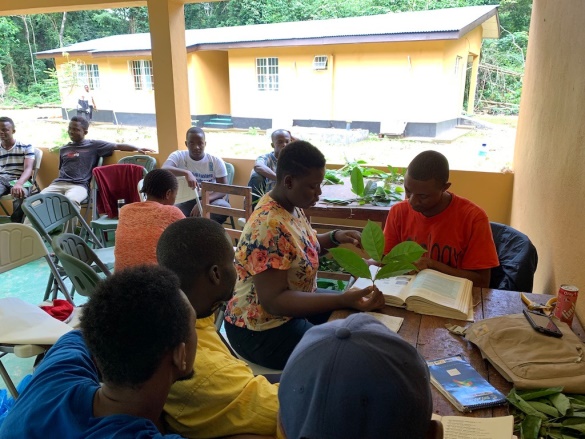By Ralph Sesay
Sierra Leone’s only National Herbarium is housed in the Department of Biological Sciences at Njala University and is fighting several battles of survival. Prof. Aiah Lebbie,who is heading the Department, on the 18 June 2020, described Sierra Leone’s National Herbarium, as a national asset of scientific, cultural and historical significance with its founding dating back to the early 1900s, and was already in existence long before the Sierra Leone Museum was founded in 1957.
A good number of energetic plant collectors resident in the country in the colonial period contributed to its humble beginning, collecting plant specimens across the country and archiving them for scientific purposes.
The most prolific collector was a British Plant Pathologist/Mycologist by the name of Frederick C. Deigthon who resided in Sierra Leone between1926-1955 and made thousands of collections of plants and fungal specimens and as well published a vernacular botanical vocabulary for Sierra Leone. Other botanists, including Sierra Leonean collectors, have also made significant contributions to the National Herbarium, collecting plant families, genera and species endemic to the sub-region, and Sierra Lone in particular.
In Sierra Leone’s long period of civil conflict, the National Herbarium was briefly invaded by rebels, who threw open the doors of cabinets archiving specimens and upon realizing nothing of “significance” to them, left them exposed to the elements for a considerable period of time. Some specimens were lost as a result of this, and entire carpological specimens (seeds, fruits, wood and fungi) were destroyed altogether. Later, thieves removed all the glass panes to the wall cabinets where those specimens were housed.
The dire economic situation of Njala University has not contributed in salvaging the challenges the herbarium faces. With no operating cost and support for archival materials, as well as resources to make field collections of plant specimens, the herbarium is at a cross road.
Furthermore, the space for processing field specimens and archiving the thousands of plant specimens is barely more than 900 square feet. This result in non-fumigated or untreated plant materials laden with insects and fungi, causing damage to invaluable plant specimens. Some specimens have been damaged as a result of insects. There is no freezer to treat plants from the field before archiving, and this causes their shortened shelf life.
Staff turnover has been high and the full complement of staff needed to make it functional no longer exists. Currently, it is only Prof. Aiah Lebbie and a technician who run the herbarium. An undergraduate female intern from Njala University and a postgraduate student assist in sustaining activities in the herbarium. As staffs get retired or pass on, the university has not been able to seek their replacements for nearly two decades. There is grave concern from Prof. Lebbie (who heads the herbarium as well as the Department of Biological Sciences) as to the long-term survival of the National Herbarium given the lack of new staff hiring and training of key technical staff.
The Royal Botanic Gardens at Kew (UK) has had a long history with the National Herbarium of Sierra Leone, supporting the initial identification of all plant specimens collected and deposited in the herbarium. The institution also provided training for key technical staff at the time, but this relationship virtually waned and support to the herbarium ceased for a considerable period of time. In the last decade, The Royal Botanic Garden reengaged with staff at the herbarium through consultancies they were providing to mining and hydroelectric companies in Sierra Leone.
Joint plant collections were made with herbarium staff and students at Njala University, providing invaluable hands on training, as well as contributing to the herbarium collections.
Material support also poured in, especially field equipment and archiving materials, which are hitherto impossible to acquire in country. Above, the joint collections have led to the discovery of new plant species.
Students of botany, agriculture, food science, natural resources and forestry benefit from the wealth of plant materials housed in the National Herbarium of Sierra Leone, and proper identification of plant specimens are also vital to those in the science of medicine such as ethnopharmacology and medicinal plant chemistry. Its uses are plentiful and could be of immense support in the identification of plant resources vital in the new green economy of the nation.
Professor Lebbie has over the years continued to draw attention to the country’s national herbarium especially in terms of addressing its staffing challenges, equipment to aid in the collection and archiving of specimens, and a budget line to support regular field visits to collect and assess the conservation status of some endemic and rare plants across the country.
The habitats of Sierra Leone’s flora are becoming increasingly threatened and without the support system in place, the University might not get to learn about them and catalogue them for development purposes, as well as discover novel uses from already documented and undocumented plant species. More recently, Professor Lebbie was credited with the discovery of a near-extinct plant species which was named after him; Lebbiea grandi flora.The plant belongs to the family Podostemaceae, and is the first African genus (Lebbiea) to be published for nearly 30 years.
As the National Herbarium of Sierra Leone continues to engage with The Royal Botanic Gardens at Kew, Professor Lebbie is also calling on the university authorities to make necessary the support needed to prevent its demise. He is particularly appealing to the Government of Sierra Leone and its line ministries and parastatals (EPA and NPAA) to recognize the value in such an asset and provide the support needed for its continued existence.
The Pro Chancellor of Njala University, Professor Arthur Abraham recently visited the National Herbarium of Sierra Leone and expressed his desire to attract Government attention to garner the needed support for its long-term survival. It is hoped that this renewed interest by administrators might pave the way for national level support from all stakeholders in ensuring this scientific, cultural and historical asset is saved from demise. The University says they can only hope so furthering that as the efforts of people like Prof. Lebbie and his students remain high, and the support of the Africa & Madagascar Team at the Royal Botanic Gardens at Kew continues, this national icon is assured of its place for all of humanity.





